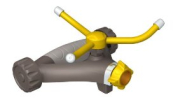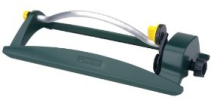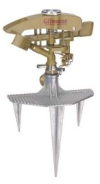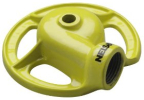
Four types of sprinklers
Since drip irrigation
didn't work for the majority of our garden, we turned to
sprinklers. We probably spent over a hundred dollars over the
last two summers searching frantically for a sprinkler that fits our
needs. Here's what we discovered about the four major types of
sprinklers:
 Rotary sprinkler --- water gets forced out of
two or three spinning arms, irrigating a circular area. The
problem is that the water outlets are very small and clog easily in
turbid water. When one arm clogs, the sprinkler stops spinning
and just sits there soaking two spots in the garden until you run out
and poke at the clogged arm with a pin, getting soaked in the
process. (Yes, I speak from personal experience.)
Rotary sprinkler --- water gets forced out of
two or three spinning arms, irrigating a circular area. The
problem is that the water outlets are very small and clog easily in
turbid water. When one arm clogs, the sprinkler stops spinning
and just sits there soaking two spots in the garden until you run out
and poke at the clogged arm with a pin, getting soaked in the
process. (Yes, I speak from personal experience.)
 Oscillating sprinkler --- water comes out of
several holes along a metal tube, which moves from side to side so that
a rectangular area is watered. This has the same clogging problem
as the rotary sprinkler, although at least the tube keeps moving when
one hole clogs.
Oscillating sprinkler --- water comes out of
several holes along a metal tube, which moves from side to side so that
a rectangular area is watered. This has the same clogging problem
as the rotary sprinkler, although at least the tube keeps moving when
one hole clogs.
 Pulsating sprinkler --- our pride and joy!
Water comes out of a big hole in a steady stream so that the sprinkler
never clogs, then the water is broken up by moving parts into a gentle
mist. You can set the sprinkler to water a full circle or any
type of semicircle and can also set the diameter of the circle as well
as the size of the water droplets. These sprinklers have the
bonus of being able to water areas as large as 100 feet in
diameter. We started with a cheap plastic version, then upgraded
to the metal version shown here, which cost us about $10 per sprinkler
(bought in two-packs at the big box store.)
Pulsating sprinkler --- our pride and joy!
Water comes out of a big hole in a steady stream so that the sprinkler
never clogs, then the water is broken up by moving parts into a gentle
mist. You can set the sprinkler to water a full circle or any
type of semicircle and can also set the diameter of the circle as well
as the size of the water droplets. These sprinklers have the
bonus of being able to water areas as large as 100 feet in
diameter. We started with a cheap plastic version, then upgraded
to the metal version shown here, which cost us about $10 per sprinkler
(bought in two-packs at the big box store.)
 Stationary sprinkler --- this is merely a chunk
of metal with no moving parts, so it's pretty indestructible.
Like the pulsating sprinkler, there is no clogging problem, and the
kind we bought has the major bonus that it will run on low water
pressure. (We had to hook the other three types directly to the big pump
to make them run, but our stationary sprinklers run on gravity
from our thousand gallon tank.) The downside to stationary
sprinklers is that they only water small areas, but I like to use them
to fill in gaps in our irrigation setup, watering solitary beds which
would be wasteful to water with the pulsating sprinkler.
Stationary sprinkler --- this is merely a chunk
of metal with no moving parts, so it's pretty indestructible.
Like the pulsating sprinkler, there is no clogging problem, and the
kind we bought has the major bonus that it will run on low water
pressure. (We had to hook the other three types directly to the big pump
to make them run, but our stationary sprinklers run on gravity
from our thousand gallon tank.) The downside to stationary
sprinklers is that they only water small areas, but I like to use them
to fill in gaps in our irrigation setup, watering solitary beds which
would be wasteful to water with the pulsating sprinkler.
| This post is part of our Irrigation lunchtime series.
Read all of the entries: |
Want more in-depth information? Browse through our books.
Or explore more posts by date or by subject.
About us: Anna Hess and Mark Hamilton spent over a decade living self-sufficiently in the mountains of Virginia before moving north to start over from scratch in the foothills of Ohio. They've experimented with permaculture, no-till gardening, trailersteading, home-based microbusinesses and much more, writing about their adventures in both blogs and books.
Want to be notified when new comments are posted on this page? Click on the RSS button after you add a comment to subscribe to the comment feed, or simply check the box beside "email replies to me" while writing your comment.
